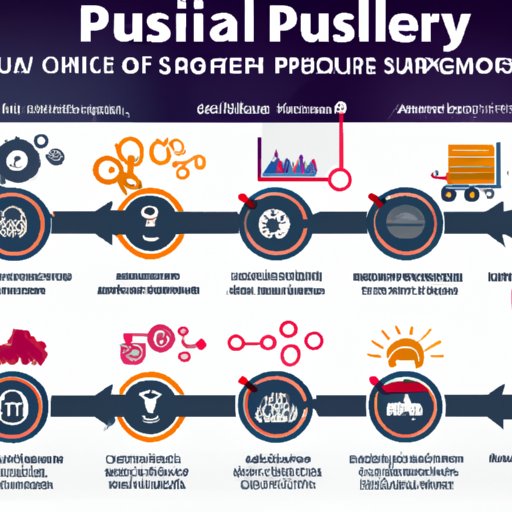Introduction
A push-pull supply chain strategy is a hybrid approach that combines elements of both the traditional push and pull strategies. The aim of the strategy is to optimize inventory management, customer service levels, and overall supply chain performance. In this article, we will look at the definition and overview of a push-pull supply chain strategy, its benefits, challenges, and components.
Definition and Overview of Push-Pull Supply Chain Strategy
A push-pull supply chain strategy is a hybrid approach that leverages the strengths of both the traditional push and pull supply chain strategies. The push strategy involves forecasting customer demand and then pushing products through the supply chain to meet this demand. The pull strategy, on the other hand, relies on customers’ orders to drive production. The idea behind the push-pull strategy is to combine the best of both worlds in order to optimize inventory management, customer service levels, and overall supply chain performance.
Benefits of a Push-Pull Supply Chain Strategy
The main benefit of a push-pull supply chain strategy is that it allows businesses to maximize their efficiency while reducing costs. By combining the advantages of both the push and pull strategies, businesses are able to better monitor and manage their inventory, reduce waste, and increase their responsiveness to customer orders. Additionally, the strategy allows businesses to increase their visibility and control over the entire supply chain process, making it easier to identify and address potential issues before they become a problem.
Comparison of Push and Pull Supply Chain Strategies
The main difference between the two strategies is the way in which they handle demand forecasting. With the push strategy, businesses rely on historical data and market trends to forecast customer demand. This information is then used to produce and ship products in advance, often with large safety stocks in case of unexpected demand. The pull strategy, on the other hand, uses customer orders as the primary source of demand forecasting. As such, products are only produced once an order has been placed.
The push strategy is more suitable for businesses in industries with predictable demand, such as consumer packaged goods. However, it can lead to costly overstocks and excess inventory. The pull strategy is ideal for businesses in highly volatile markets, where demand can fluctuate significantly. However, it can also lead to stock outs and poor customer service levels.
Challenges in Implementing a Push-Pull Supply Chain Strategy
Integrating the two strategies into one system can be complex and time consuming. In addition, there may be additional costs associated with implementing a push-pull supply chain strategy, such as training staff, purchasing new technology, and setting up new processes. Furthermore, the strategy requires accurate demand forecasting and tight inventory management, which can be difficult to achieve.
Impact of a Push-Pull Supply Chain Strategy on Overall Performance
By implementing a push-pull supply chain strategy, businesses can increase the efficiency of their operations and reduce costs. Additionally, by having a better understanding of customer demand, businesses can ensure that they have the right products available when customers want them, resulting in improved customer satisfaction. Finally, the strategy can help businesses better manage their inventory, reducing the risk of overstocking or stock outs.
Components of a Push-Pull Supply Chain Strategy
The key components of a push-pull supply chain strategy include forecasting, inventory management, and logistics. Forecasting involves using historical data and market trends to accurately predict customer demand. Inventory management involves monitoring product availability and adjusting inventory levels accordingly. Finally, logistics involves planning and managing the movement of goods from supplier to customer.
Improving a Push-Pull Supply Chain Strategy
In order to maximize the benefits of a push-pull supply chain strategy, businesses should consider automating certain processes. Automation can help streamline operations, reduce manual errors, and free up resources for other tasks. Additionally, businesses should leverage data analytics to gain a deeper understanding of customer demand and optimize their inventory management.
Role of Technology in a Push-Pull Supply Chain Strategy
Technology plays an important role in a push-pull supply chain strategy. For example, businesses can use sensors and tracking devices to monitor and track the movement of goods throughout the supply chain. Additionally, businesses can leverage optimization algorithms to identify the most efficient routes and schedules for transporting goods. Finally, businesses can use predictive analytics to anticipate customer demand and adjust their inventory accordingly.
Conclusion
A push-pull supply chain strategy is a hybrid approach that combines the best aspects of both the traditional push and pull strategies. The strategy offers businesses many benefits, including increased efficiency, improved customer satisfaction, and better inventory management. However, businesses should be aware of the challenges associated with implementing a push-pull supply chain strategy, such as complexity of integration and cost. Finally, businesses should leverage technology to optimize their push-pull supply chain strategy and maximize its benefits.
(Note: Is this article not meeting your expectations? Do you have knowledge or insights to share? Unlock new opportunities and expand your reach by joining our authors team. Click Registration to join us and share your expertise with our readers.)
